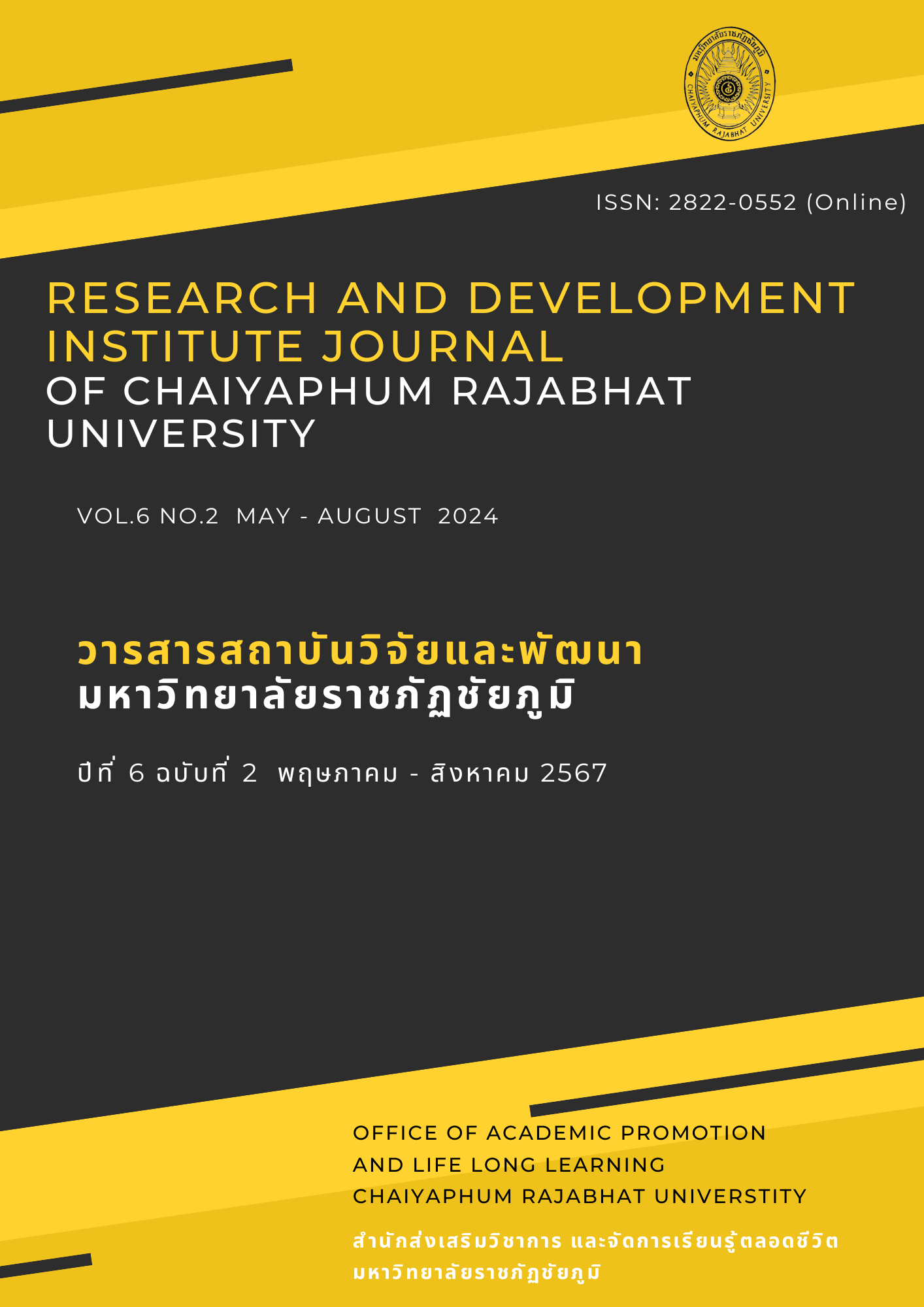DEVELOPMENT OF AN INTEGRATED GROUP COUNSELING MODEL THAT AFFECTS LEARNING BURNOUT OF STUDENTS THAILAND NATIONAL SPORTS UNIVERSITY CHUMPHON CAMPUS
Main Article Content
Abstract
This is a research-and-development model. The objectives are to 1) explore the components of student burnout; 2) design and evaluate the quality of an integrated group counseling program that addresses student burnout; and 3) Compare the effects of using the program before and after integrated group therapy on study burnout scores in the experimental and control groups; and 4) to determine student satisfaction with the integrated group counseling program. The impact of student exhaustion on learning. By selecting a purposive sample group, 16 students with academic burnout scores below the threshold were chosen to participate in the experiment. The research tools consisted of 1) an integrated group counseling program that affects students' academic burnout, 2) a student academic burnout measure, and 3) an assessment of student satisfaction following the implementation of an integrated group counseling program that addresses student academic burnout. The measuring model and evaluation form were validated for content validity by 8 experts, with an IOC value ranging from 0.80 to 1.00. Statistics were used. The data was analyzed using mean, standard deviation, and Mann-Whitney U test statistics.
The research results were as follows:
- The components of study burnout are emotional exhaustion, personal exhaustion, and the exhaustion of the individual results.
- An integrated group therapy treatment that addresses weariness. Students' learning satisfaction has a mean of 4.56 and a standard deviation of 0.46, which is ideal.
- Following participation, students exhibit higher levels of learning burnout. The integrated group counseling program had a lesser influence on academic burnout ratings than the study burnout before the experiment, which was significantly different at 0.01.
- Students are satisfied with the integrated group counseling program, which reduces academic burnout with maximum satisfaction. The overall average was 4.53.
Article Details

This work is licensed under a Creative Commons Attribution-NonCommercial-NoDerivatives 4.0 International License.
Permission to use text, content, images, etc. of publication. Any user to read, download, copy, distribute, print, search, or link to the full texts of articles, crawl them for indexing, pass them as data to software, or use them for any other lawful purpose. But do not use it for commercial use or with the intent to benefit any business. Published under a Creative Commons Attribution-NonCommercial-NoDerivatives 4.0 International License.

This work is licensed under a Creative Commons Attribution-NonCommercial-NoDerivatives 4.0 International License
References
ชัยพร พงษ์พิสันต์รัตน์. (2562). การพัฒนาโปรแกรมการให้การปรึกษากลุ่มตามแนวทฤษฎีเผชิญความจริง เพื่อลดความเหนื่อยหน่ายในการเรียนของนิสิตนักศึกษาระดับอุดมศึกษา. [ปริญญานิพนธ์ดุษฎีบัณฑิต]. มหาวิทยาลัยมหาสารคาม.
ฝ่ายสื่อสารองค์กรและเทคโนโลยี สถาบันราชานุกูล. (ม.ป.ป.). เด็กไทยเรียนหนักที่สุดในโลก. สถาบันราชานุกูล. สืบค้นเมื่อวันที่ 10 มกราคม 2565 จาก https://shorturl.at/mhQHR
พรรณวิภา บรรณเกียรติ สุวรรณา อนุสันติ และนิราศศิริ โรจนธรรมกุล. (2565). การพัฒนาโปรแกรมฝึกอบรมการเสริมสร้างสมรรถนะการให้คําปรึกษาสุขภาพจิตนักเรียนที่มีความบกพร่องทางการเห็นสำหรับครูโรงเรียนสอนคนตาบอด. วารสารสุขภาพกับการจัดการสุขภาพ, 8(1), 165 - 178.
สำนักงานเลขาธิการสภาการศึกษา. (2560). แผนการศึกษาชาติ พ.ศ. 2560 - พ.ศ. 2579. กรุงเทพฯ: พริกหวานกราฟฟิค.
สิริยากร เดชมณีธร. (2562). ภาวะเหนื่อยหน่าย (burnout) ของพนักงานเจเนอเรชั่นวายที่ทำงานในธนาคาร : กรณีศึกษาเปรียบเทียบธนาคารของรัฐและธนาคารเอกชน. [วิทยานิพนธ์ปริญญามหาบัณฑิต]. มหาวิทยาลัยธรรมศาสตร์.
Abós, Á., Sevil-Serrano, J., Haerens, L., Aelterman, N., & García-González, L. (2019). Towards a more refined understanding of the interplay between burnout and engagement among secondary school teachers: A person-centered perspective. Learning and Individual Differences, 72, 69–79. https://doi.org/10.1016/j.lindif.2019.04.008
Cronbach, L. J. (1970). Essentials of psychological testing. 3 rd ed. New York: Harper & Row.
Fiorilli, C., De Stasio, S., Di Chiacchio, C., Pepe, A., & Salmela-Aro, K. (2017). School burnout, depressive symptoms and engagement: Their combined effect on student achievement. International Journal of Educational Research, 84, 1–12. https://doi.org/10.1016/j.ijer.2017.04.001
Krejcie, R. V., & Morgan, D. W. (1970). Determining Sample Size for Research Activities. Educational and Psychological Measurement, 30(3), 607–610. https://doi.org/10.1177/001316447003000308
Luo, Y., Wang, Z., Zhang, H., Chen, A., & Quan, S. (2016). The effect of perfectionism on school burnout among adolescence: The mediator of self-esteem and coping style. Personality and Individual Differences, 88, 202–208. https://doi.org/10.1016/j.paid.2015.08.056
Ma, H., Zou, J., Zhong, Y., Li, J., & He, J. (2022). Perceived stress, coping style and burnout of Chinese nursing students in late-stage clinical practice: A cross-sectional study. Nurse Education in Practice, 62, 103385. https://doi.org/10.1016/j.nepr.2022.103385
Salmela‐Aro, K., & Tynkkynen, L. (2012). Gendered pathways in school burnout among adolescents. Journal of Adolescence, 35(4), 929–939. https://doi.org/10.1016/j.adolescence.2012.01.001
Wang, M.-T., Chow, A., Hofkens, T., & Salmela-Aro, K. (2015). The trajectories of student emotional engagement and school burnout with academic and psychological development: Findings from Finnish adolescents. Learning and Instruction, 36, 57–65. https://doi.org/10.1016/j.learninstruc.2014.11.004
Wei, X., Wang, R., & MacDonald, E. (2015). Exploring the Relations between Student Cynicism and Student Burnout. Psychological Reports, 117(1), 103–115. https://doi.org/10.2466/14.11.PR0.117c14z6
Widlund, A., Tuominen, H., Tapola, A., & Korhonen, J. (2020). Gendered pathways from academic performance, motivational beliefs, and school burnout to adolescents’ educational and occupational aspirations. Learning and Instruction, 66, 101299. https://doi.org/10.1016/j.learninstruc.2019.101299


